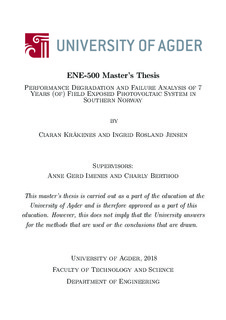| dc.description.abstract | This thesis covers an analysis of performance degradation and failure detection of thin-film
(Sharp) and m-Si (REC and Suntech) PV modules located at Kjøita in the south of Norway.
The analysis consists of performance evaluation, visual inspection, IR imaging and I–V curve
measurements. Performance ratios were calculated based on DC data from the past six years.
Detection of failures and determination of degradation rates was based on the proposed inspection
methods. The results have been analysed to obtain an in-situ overview of the system states
concerning degradation and failures. The complementarity between the methods is studied to
determine their effectiveness and reliability.
Analysis of the modules makes it evident that all three systems show signs of degradation. The
degree of degradation is, however, varying. Based on the I–V analysis, and assuming initial
conditions corresponding to manufacturer specifications, it can be concluded that the Suntech
modules have the lowest degradation in Pmpp of (-0.47%/yr). Followed by REC (-1.07%/yr)
and Sharp (-3.35%/yr), which even exceeds the warranty limit (-1.00%/yr). The majority of
failures, in the form of hot spots, were found on the REC modules, which resulted in higher
degradation rates for REC. The modules with hot spots were categorised as defective, and
replacement of the modules was recommended.
IR is found to be an easy, cost-effective and reliable method to detect failures. However, we
recommend visual and I–V inspection to complement the analysis and failure diagnosis. In
some cases, a clear failure diagnosis based only on the proposed methods is not possible, and
other methods such as EL and UV fluorescence should be used. Last, a procedure for long-term
analysis of field exposed systems was proposed. The procedure involves performing initial I–V
curve measurements, IR analysis and visual inspection to establish initial condition, in addition
to annual measurements, in the following years. | nb_NO |

